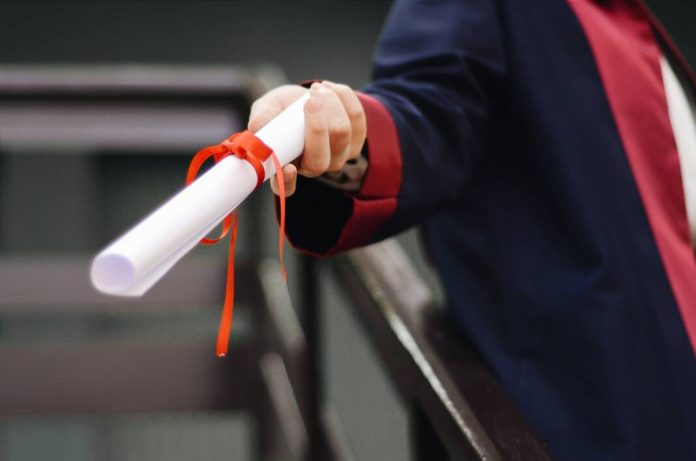In 2026, the high-school-aged population in the United States will peak at about 3.5 million students and then decline by 15% in the following 18 years. This is the demographic-driven phenomenon that colleges and universities are calling the enrollment cliff.
The enrollment cliff sparks some questions: If there are fewer and fewer traditional college-aged students, how will universities sustain enrollment? And maybe even more importantly, how will the U.S. labor force continue to be globally and nationally competitive without a pool of educated employees?
Courtney Brown, Lumina Foundation for Education’s vice president of strategic impact and planning, specializes in following and studying data trends within higher education.
According to Brown, Indiana’s current college-going rate is at an all-time low. Data from the class of 2022 showed that only 53% of graduates attended college.
“I believe that the number of Indiana high-school students going directly into college is decreasing, and that is a concern that we need to take seriously,” she said.
Brown said that many students at big state schools like Indiana and Purdue universities are coming from out of state. She is concerned about the lack of enrollment from in-state students.
According to Brown, Indiana’s K-12 school systems can work to increase Indiana students’ enrollment into the state’s colleges. Currently, K-12 educators have implemented both dual credit opportunities and the 21st Century Scholars program to encourage high-school students to attend university.
She said many students in Indiana can’t attend college because it is not affordable. Now that the 21st Century Scholars financial aid program has instituted an automatic enrollment policy for eligible eighth graders, Brown says college could be more accessible.
“No one program is going to do it all, but along with these programs, we need to make sure that students are getting mentoring so that they understand that college can be for them,” said Brown. “They can be college ready.”
When it comes to maintaining competitiveness in the workforce, Brown said the majority of workers need to have attained a bachelor’s degree. Without a population that has attained higher education, she says, companies will have to go elsewhere for qualified labor.
“We’re not continuing to build the technology we need when many countries around the world are increasing attainment,” said Brown. “It’s a problem nationally because we are not going to be globally competitive.”
While Brown is focused on what K-12 educators can do to increase enrollment, other experts in higher ed believe institutions should start thinking beyond the traditional 18- to 24-year-old population when it comes to encouraging prospective learners.
“Although the high-school population may be peaking, there are still more people who will need and who may want to pursue postsecondary-level education,” said Hironao Okahana, the assistant vice president and executive director of the Education Futures Lab at the American Council on Education.
The American Council on Education provides credit recommendations for colleges and universities. For example, if someone receives a training certificate in the workforce, military or some sort of other nontraditional college or university space, the council will advise colleges on how a student can receive credit for that certificate or training.
Okahana said that these types of recommendations help engagement with people outside of the traditional college-aged population.
“There will be more than one on and off ramp between postsecondary institutions and the workforce and vice versa,” said Okahana. “I think the key part is that we know that prospective post-secondary learners are not just 18 years old.”
Brooke Kile, associate commissioner for business intelligence at the Indiana Commission for Higher Education, emphasized military members and adult learners as groups universities should serve.
“One of the things the commission is really focused on is identifying other populations to encourage and help obtain college access,” said Kile.
Kile highlighted the commission’s Collegiate Purple Star Program. According to its website, the Collegiate Purple Star Award “recognizes an eligible postsecondary institution that has successfully demonstrated a supportive environment for its United States military-affiliated student population from application to graduation.”
“We will be inviting institutions to participate in making their campuses military engaged,” said Kile.
By Anna Cecil, who is a reporter for TheStatehouseFile.com, a news website powered by Franklin College journalism students.





